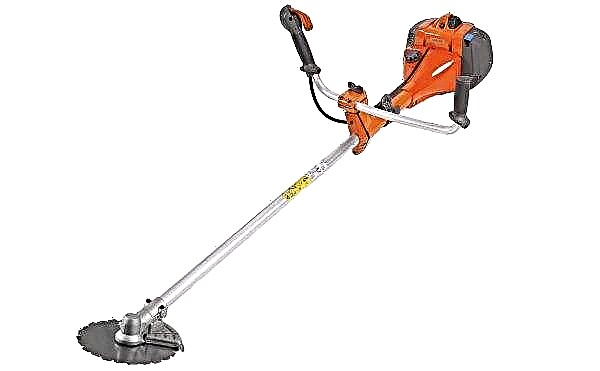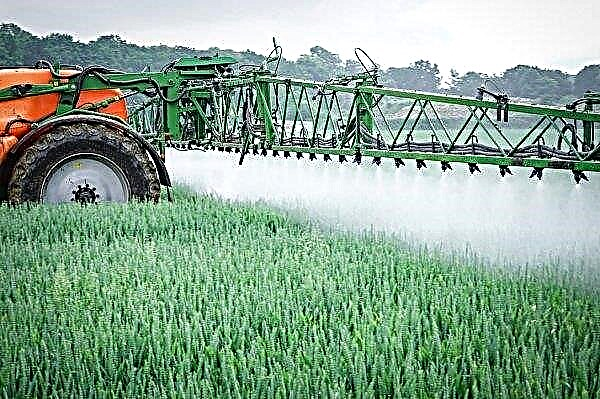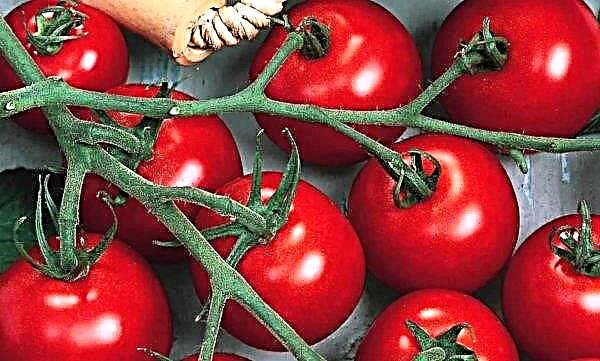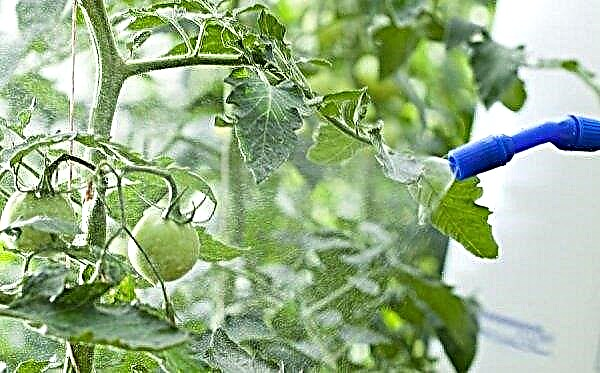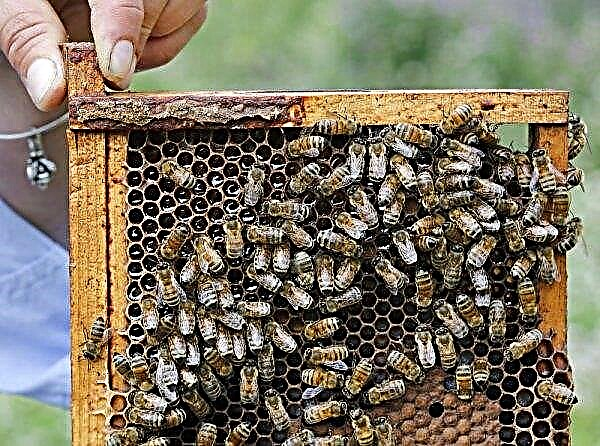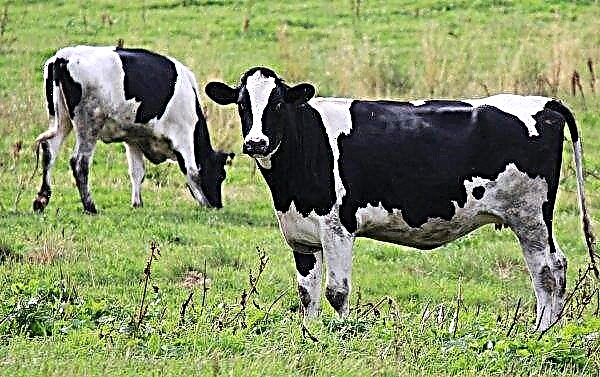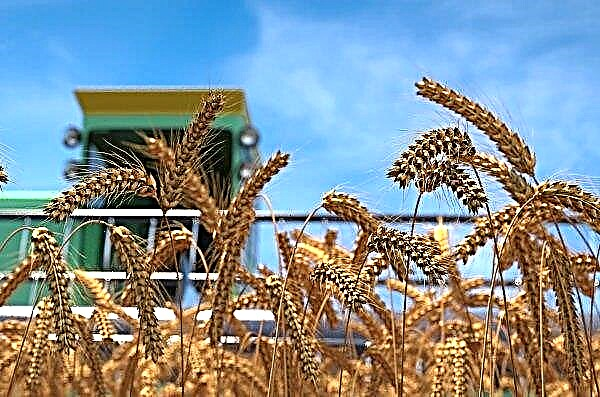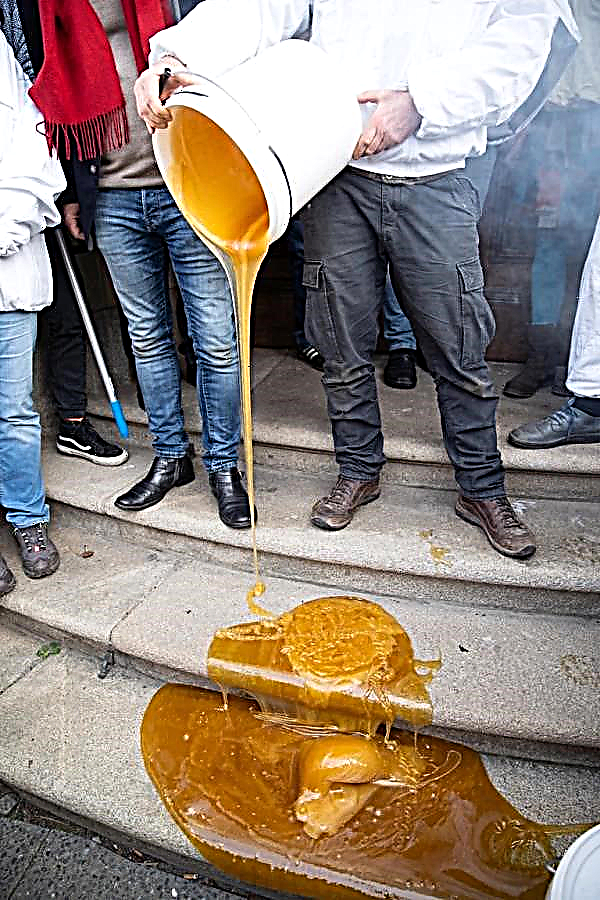The species and varietal variety of wheat varieties allows modern farmers from all over the world to get good, high-quality grain crops, especially if all the requirements of the crop were taken into account during the sowing and further cultivation. Its most popular varieties include winter and spring wheat, the cultivation of which is practiced not only in Russia, but also in other countries. Important issues at the same time were and remain the specific time of sowing grain, preparatory measures, the rules for performing all actions, the depth of sowing seeds and how to care for emerging sprouts.
When is it better to sow wheat
One of the main differences between winter and spring wheat is the duration of the growing season of both crops. In the first case, its duration is on average 280 days, and in the second - not more than 100 days, which in many respects affects the specific time of sowing. Not surprisingly, each of these cases has its own characteristics.

Winter
The specific timing of sowing seeds of winter wheat is determined taking into account weather conditions, predecessors, moisture and soil structure, which in different parts of the Russian Federation can have significant differences. If the crops are sown too early, the seedlings are often struck by the Swedish and Gassen flies, winter shovels, powdery mildew and brown rust, and with early snowfall and the absence of freezing temperatures that are standard for winter, it is possible to soak and grill crops.
Important! To increase the chances of abundant germination of winter wheat, plant the grain in a moistened substrate.
Late sowing of winter wheat reduces crop yields, which is explained by the poor development of plants before leaving for winter (young seedlings simply do not have time to grow or form nodal roots, which is why they most often die).
On average, farmers are guided by the following crop planting dates:
- in the northern regions - from August 25 to September 10;
- in the central regions - from September 1 to September 15;
- in the southern regions - from September 1 to 15.
Video: Norms and terms for sowing winter wheat
Spring
As in the first case, too early or too late sowing periods are undesirable for a plentiful spring wheat crop, but taking into account the growing climate region and weather conditions will be relevant in any case. The most difficult issue is the time frame southern, forest-steppe and steppe zones of Russia, where the snow cover is not as powerful as in the northern regions, and leaves the fields early.
In this regard, the soil thaws very slowly, and its top layer is very dry under the influence of winds, in addition, cases of return frosts in the spring are not uncommon. Sustainable heating of the soil at the depth of incorporation occurs at the beginning of May, and only in certain periods - at the end of April.
In the European part of Russian territory the best and most stable spring wheat crops can be obtained with early sowing crops, which can not be said about the forest-steppe and steppe zones of Western Siberia and Northern Kazakhstan (they remain relevant here average sowing season for spring wheat, approximately between May 10–25) Late-ripening varieties show higher harvesting efficiency at relatively early sowing dates, and early ripe ones at later ones.
On average, sowing operations during the cultivation of spring wheat in most of Russia begin as early as possible, immediately after the temperature of the sowing layer reaches + 4 ... + 5 ° C. Having appeared above the soil surface, young sprouts are able to withstand short-term drops to -10 ° C. Adhering to the temperature regime in choosing a specific sowing time, it is worth planning planting activities during the first five days after the soil reaches its optimal values. Being late for 7-10 days, you can lose up to 30% of the grain harvest.

Seeding dates in different regions of Russia
The following cultivation regions and the most suitable time for planting material can be distinguished:
- The Far North (in particular, the Arkhangelsk, Tyumen, Irkutsk and Sakhalin Regions) - August 1–15;
- Central Black Earth zone and the south-eastern part of the country (including Voronezh, Lipetsk, Bryansk, Belgorod, Kursk, Oryol, Tula and Volgograd regions) - from August 20 to September 1;
- Volga region (for example, Saratov, Orenburg, Astrakhan regions, the Republic of Kalmykia) - from September 1 to September 20;
- foothill regions of the North Caucasus (including the Chechen, Ingush republics, Dagestan, North Ossetia) - from September 15 to October 5.
Did you know? People began to cultivate wheat in the XIII – XII centuries. BC e., starting with the territories of the Middle East (it was there that archaeologists found confirmation of this). At the beginning of our era, cereals came to Asia and Africa.
In outskirts of Moscow Winter wheat is sown from about August 20 to 25, although many farmers adhere to dates characteristic of the rest of the Central Black Earth zone.
As for the beginning of the sowing campaign of spring wheat, then in central and southern regions of the Russian Federation the procedure is already underway from mid-April, and in the northern regions this is often delayed until the second half of May. The choice of a specific time directly depends on the rate of thawing of the soil and its warming up at the required embedment depth.

The best predecessors
Each type of wheat has its own desirable and undesirable predecessors, although by and large both options belong to the group of cereal crops, so there will be no significant differences in this regard.
It is best to sow them after:
- legumes (in particular, soybeans, peas, chickpeas);
- row crops (for example, corn, potatoes, sugar beets, cotton, clover, buckwheat, flax, but not a sunflower clogging the field with a scavenger);
- grassy - oats, sainfoin, soybeans of early ripening varieties grown in conditions of insufficient humidity (after which winter wheat brings large yields).
In some cases, spring wheat can be sown after winter, but this only contributes to the spread of pests and diseases in the field, which in any case will not affect the future crop in the best way. Cereals grow well on plentifully fertilized soils, so when cultivating row crops in front of them, it is so important to apply at least 40 tons of organic fertilizers per 1 ha of planted area.

Soil preparation for sowing
Features of soil preparation for sowing winter or spring wheat largely depend on the timing of harvesting and the type of predecessors grown earlier. So, if more than two weeks have passed from the moment of the last harvesting events to the sowing of winter crops, then it is preferable to perform surface cleaning using discs to a depth of 6-8 cm, which will reduce moisture loss and destroy weeds.
After spring crops, one- or two-time disk stubble cultivation is carried out with an interval of 2-3 weeks. A single peeling is used mainly after growing annual crops, while a double peeling is more relevant when the territory is heavily clogged with perennial root shoots. In the first case, we are talking about a disk 6–8 cm impact, and in the second, a disk or plane-cutting impact to a depth of 12–14 cm.
Before sowing spring wheat, the chill in most regions of the Russian Federation is left in a combed form, which is not relevant only in arid steppe areas with little snowy winters and severe drying of the ground by winds. In this case, early spring deep plowing of the soil with plows will be relevant, preferably with simultaneous soil leveling. In Western Siberia and in the regions of the North Caucasus, erosion-free soilless soil cultivation using flat-cutting tools is often introduced. In heavily clogged areas, it is better to combine non-stocking and heap processing, especially in seasons with high humidity.
 In addition to choosing a specific method of soil treatment, it is equally important to correctly calculate the dosage of fertilizers and properly prepare the seed.
In addition to choosing a specific method of soil treatment, it is equally important to correctly calculate the dosage of fertilizers and properly prepare the seed.
Fertilizer application
Both types of wheat described are in need of adequate nutrition.otherwise, it is impossible to guarantee a rich grain harvest. In each of these cases, a different amount of mineral fertilizers will be relevant, but be that as it may, it will have to supply the soil with enough nitrogen, phosphorus and potassium.
When growing winter wheat and the planned harvest at the level of 50–60 kg / ha, the consumption of nutrients from the soil by plants will correspond to the following values: nitrogen - 160–190 kg, phosphorus - 55–70 kg, potassium - 80–100 kg per 1 ha . The optimal level of acidity in fertile soils should be 6–7 pH. The most effective was the fractional application of nitrogen fertilizers, consisting of the main dressing used during the sowing of wheat and further fertilizers in accordance with the period of vegetation of plants.
Important! Row fertilizing under winter wheat significantly increases the duration of sowing and increases the concentration of soil solution. Dissolving directly next to the seeds, granules reduce their germination by 3–6%, so this method of fertilizer is not always suitable.
In general, the winter cereal fertilizer scheme looks like this:
- When sowing grain, they contribute no more than 30–40% of the nutrients of the total calculated dose (for example, to grow 50–60 kg / ha of the crop, approximately 110–150 kg / ha of ammonium nitrate or nitrogen sulfate will be required). Phosphorus and potassium are introduced during the main top dressing of the soil in full.
- In early spring, during the resumption of wheat vegetation processes, the same amount of ammonium nitrate or superphosphate can be added that was already used during planting.
- During the tubing period, winter wheat is fed a second time, using already a 20–30% solution of urea-ammonia mixture.
- The best nitrogen-containing fertilizers in the sowing period are considered to be ammonium nitrate, nitrogen sulfate, complex mineral fertilizers. The latter are much more effective than fertilizer mixtures.

Prevent or eliminate an already existing iron deficiency in winter wheat crops using complex water-soluble micronutrient fertilizers (put into the ground during the autumn and spring tillering). Typically, Kelkat Mix fertilizer is used for this purpose, at least 0.5 kg per 1 ha of crops. When growing spring wheat with a less developed root system, it is worth considering its increased requirements for the mineral composition of the soil.
Important! For the fastest feeding of wheat, small planes are used, equipped with tanks necessary for liquid. The ground-based method of introducing nutritional compositions will be relevant only in the case of maintenance of limited area fields.
She needs the greatest amount of nutrients in the first half of the growing season (that is, before active flowering). In percentage terms, it is 82–90% nitrogen, 82–100% phosphorus, 100% potassium. In the phase of tillering and exiting plants into the tube, they absorb about 40% of the nitrogen consumed during the entire growing cycle. The initial period of development of spring wheat is considered critical in the issue of consumption of phosphorus and potassium, so it is so important to add their maximum amount before sowing. Normally, a single dosage of nitrogen for the planned harvest within 50-60 kg / ha amounts to 260 kg of ammonium nitrate per 1 ha of crops, 45 kg of phosphorus and 60 kg of potassium per similar area. The latter are introduced in autumn under autumn plowing.
Of the trace elements important for spring wheat will be copper sulfate, which is fed during the tillering phase of plants with access to the tube. In this case, no more than 350 g of substance for foliar feeding is used per 1 ha. In the case when the soil acidity exceeds 6 pH values, it is worth including manganese in the fertilizer (250 g of manganese sulfate per 1 ha).

Seed preparation
For sowing any kind of wheat, exclusively peeled and sorted seeds are suitable without signs of rot or pest damage. The best crops can be obtained from large specimens, when the mass of 1000 grains of soft varieties is 35–40 g, and hard - at least 40 g.
To prevent the occurrence of solid smut, the method of dry dressing of grain is usually used. (special solutions and suspensions are mixed with planting material in special machines several months before sowing), and for the prevention of smut smut, thermochemical dressing will be more effective (if the seeds are soaked for a short time in a chemical solution, such as granozan, it is cooled and dried).
Often, planting material lends itself to inlays., covering each grain with successive layers of fungicidal, bactericidal, insecticidal preparations, as well as growth stimulants and neutral dyes, providing a more uniform distribution of wheat in the soil during planting. Inlay can be performed both a few months before sowing, and just before the implementation of planting events. High-quality seeds selected and properly treated are much less likely to rot, mold, and suffer from popular wheat ailments.

Sowing rules
The success of wheat cultivation and the volume of harvested crops are affected by the number of seeds sown on 1 hectare of the area, the depth of their seeding in the ground and the method of sowing. In the case of spring and winter crops, each of these actions has its own characteristics.
Seeding rates
The seed sowing rate is called the number of seeds, when planted on 1 ha of land, a full crop of this crop will be provided. This indicator is expressed in the number of germinating seeds (measured in millions of pieces) and their mass (in kilograms).
The main factors affecting the sowing rate are rightly considered:
- the specific purpose of cultivating the crop;
- quality of seeds purchased for sowing;
- sowing method;
- climatic conditions in the growing region;
- soil condition.
It turns out that even within the framework of growing one crop, the seeding rate may differ: for example, when cultivating wheat for silage, more planting material will be required than for obtaining grain from it. In northern areas, consumption will also be higher than in southern areas.

The weight sowing rate of wheat is determined by the formula: HBV = M × K, where M - this is the mass of 1000 seeds, and K is the number of clean and germinating grains sown on 1 ha of area in a specific zone of Russia (calculated in millions). The average values of the second indicator for the regions of Russia are shown in the table below:
| Seeding zones | Winter wheat (million / ha) | Spring wheat (million / ha) |
| Volga region | 4,5 | 4,5 |
| Forest steppe | 5,0 | 5,0 |
| Central Black Earth Strip | 5,0 | 6,0 |
| Central areas of the non-chernozem zone | 5,0 | 6,5 |
The calculated weight rate of the grain determines kilograms of pure seeds with 100% germination capacity, embedded in the soil on an area of 1 ha. However, in real conditions, the sowing suitability of the used wheat is below 100%, therefore, it is advisable to amend the sowing rate based on the actual sowing suitability, calculated by the formula: PG = (purity × germination) / 100.
For example, when calculating the weight norm of sowing seed material for winter wheat in the Volga region, taking into account a purity of 98%, germination within 96% and a mass of 1000 seeds, about 50 g All mathematical operations will be performed in the following sequence:
- First, the correction for the actual sowing validity of the grain is calculated: GH = 98 × 96/100 = 94%.
- Then, the seeding rate of planting material is calculated with the obtained GH result (94%): HB = 50 × 4.5 × 100/94 = 239 kg / ha.
In the same way, you can get the required values for other regions of the Russian Federation, and before sowing both winter and spring wheat.
Video: How wheat grows, from grains to harvesters
Seeding Depth
The seeding depth of the seed material directly depends on the soil composition, plant variety and crop cultivation conditions. The average values for spring wheat are 4–5 cm, although on sod-podzolic soils it is allowed to reduce these values to 3-4 cm, and on peat soils to 2-4 cm. Varieties with a short stem can be planted even to a deeper depth, but always in a moist substrate and on a compacted surface.
Did you know? Many legends have long been associated with wheat grains, but Slavic peoples considered it a symbol of wealth, life, and even endowed it with magical properties of protection from the "evil eye" and damage.
Determining the optimal level of landing winter wheatIn addition to all of the above criteria, for spring crops, it is also worth considering the timing of planting events, the particle size distribution of the soil and the size of the selected seed material. The averaged values in this case will be 5–6 cm, which is explained by a deeper laying of the tillering node of such wheat. With shallow embedding, the likelihood of the crop saping or freezing up significantly increases.
If you choose the optimal depth of sowing of winter wheat, taking into account the type of soil in a particular region, then the following values will be relevant:
- for chernozem soils and arid places - it is 6–7 cm;
- with strong drying of the upper soil layers of chernozem - 8-10 cm;
- in non-chernozem regions with heavy clay substrates prone to compaction and swimming, 4–6 cm.

Sowing methods
To the most popular options when growing winter crops include narrow row, ordinary and cross methods of sowingEach of which has its advantages and disadvantages. So, due to the need for high costs, the latter is rarely used today, and the best direction of sowing is considered across the slope, which reduces the flow of water and the likelihood of soil erosion.
On lowland fields, north-south rowing is the best solution., which will improve the illumination of plants. Narrowness in this case plays an important role, therefore, it is worth leaving no more than 10 cm of free space between adjacent rows. Cross-sowing of winter crops is successfully practiced in many regions, in which one part of the norm is sown across the field and the other along.
Spring wheat yields abundant crops when sowing, while cross-planting sometimes leads to delayed sowing dates, excessive compaction of the soil and additional fuel consumption not only during the sowing campaign, but also in the process of further care for cereals.

How to care for crops
Both spring and winter wheat cannot be called too capricious crops, but for their productive cultivation it is worth considering some features of each type of wheat.
When cultivating spring wheat, they practice rolling it with special rollers (to ensure the most dense interaction with the soil), harrowing the soil as the substrate dries in the spring (to prevent excessive drying of the earth, heavy tooth harrows in one or two tracks are used). In addition, fertilizing with fertilizers and measures to destroy weeds always remain relevant.
Harrowing to a depth of not more than 3 cm, only young weed shoots can be destroyed, but in order to completely get rid of them, herbicides will have to be used (sprayed in the fields with the help of boom sprayers). In arid regions, irrigation of wheat will be relevant, for which special irrigation machines are used.
Important! Any chemicals for processing wheat can be used no later than 20-30 days before harvest.
When growing winter crops, all the basic care methods remain the same, except that they add snow retention. It is relevant for the steppe and forest-steppe zones with an arid climate, where without additional exposure it will not be possible to provide wheat with optimal moisture and abundant productivity. The most popular methods of achieving goals today include the installation of artificial barriers and the planting of forest belts. In areas where this is not possible, large boulders of snow are completely raked up, completely covering areas with sown wheat.
At the end of spring tillering, to prevent lodging, crops are treated with a tour solution in the calculation of 3-4 kg of the drug per 100 liters of water. Of the herbicides, Puma Super (consumption 0.6–0.75 l / ha) and Dialen Super (0.6–0.8 l / ha) are appropriate. Both drugs are used for growing a wide variety of winter crops.

Ways to control pests and diseases
Winter and spring wheat often suffer from the same ailmentstherefore, when growing them, it is often relevant to use the same chemical compositions for processing. However, do not forget that in winter, many pathogens are suppressed by severe frosts, so when cultivating winter wheat, diseases are less common.
The main diseases of cereals include rust, powdery mildew, root rot, smut and bacteriosis. In case of mass damage, Baytleton, Tiltom, Fundazole are used in the fight against them (the norms and terms of their use are usually indicated by the manufacturer on the package). If a single treatment is not enough, you can repeat the action after a ten-day interval. Without a timely reaction to an ailment, it is possible to slow down the growth of culture, change the familiar color of spikelets and stem, and the absence of ovaries. From powdery mildew, wheat is sprayed in the bumping phase, and from rust already during earing.
The main pests of crops are often the bread bug, cereal flies, bread leeches, ground beetles, bread fleas, aphids, thrips. Effective insecticides will be preparations "Karate", "Bazudin", "Diazinon", "Kinmix", "Fastak", one part of which is used during tillering or at the beginning of the plants in the tube, and the second part during grain filling (relevant in fight against larvae of aphids, thrips, malicious turtles).
For quick and efficient distribution of the selected composition across the field, special tank sprayers are used (for example, POM-630-1), with which plants are treated on separate ruts (this technology simplifies work and ensures that chemicals reach the right place).

Harvest
Depending on the type of wheat, harvesting of a ripened crop has its own characteristics. So, when cultivating the spring variant, two traditional methods of harvesting events became widespread - direct combine and separate collection. In the first case, a combine harvester with a header is used, and in the second, two stages of work are provided: first, the wheat is mowed with a roller header, and after partial drying in the rolls, it is selected and threshed.
Depending on the specific conditions of harvesting the crop (soil moisture, weather conditions, ripening and weediness of the site), a combination of both methods for harvesting with minimal losses is possible. The average duration of spring wheat harvest in favorable weather is 7–10 days and in different regions it can occur both at the end of July and at the beginning of August. If a week after full ripeness of the grain is not removed, a significant part of the crop will be lost.
Harvesting winter wheat usually begins earlier than harvesting spring, - in the phase of wax ripeness of the culture, when the seed moisture is not higher than 28% (in most regions this period falls at the end of June - mid-July). It is possible to use the method of direct and separate combining. The first option is more economically advantageous (all work is done in one approach), but with uneven ripening of wheat will have to use a separate method.
They spend no more than 2–3 days on drying the mowing of winter crops, after which they select and thresher the ears of grain with combine harvesters. To avoid significant crop losses, harvesting must be done before the ears are completely dry, cracking and crumbling. On average, they take no more than 10 days. Ground grain is transported to the elevator, where it is further processed using drying and treatment units.

Grain cultivation and collection is a very important event, therefore, special attention is paid to the correct implementation of all the above works. Observing the recommended time of sowing and harvesting wheat, as well as adhering to the recommendations regarding its cultivation, you can get abundant harvests, not only on state, but also on small private fields that meet the needs of an individual city or even family.

